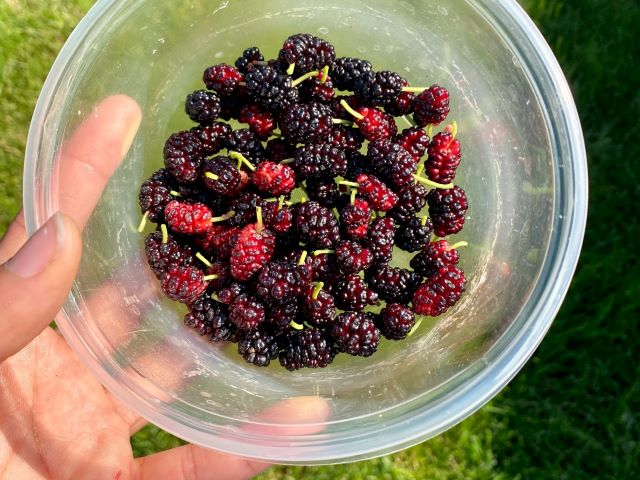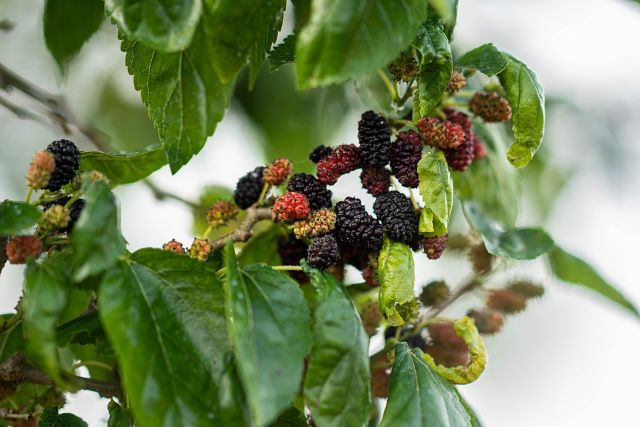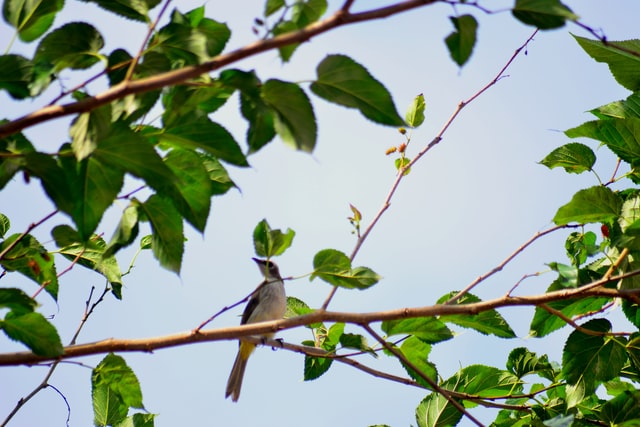Mulberries can make a delicious, fast-growing, nutrient-packed alternative to blackberries. Given they’re not usually commercially available because of a short shelf-life, growing mulberries yourself is often the only way to have a reliable store. So if your mulberry tree is fruiting but the mulberries are looking small, you’ll want to know why.

The most common causes for mulberries being small are due to insufficient water, lack of soil nutrients, or unhelpful, cold weather conditions.
There is also a chance that birds or other animals might be getting to your mulberries before you have a chance to!
Disease is relatively uncommon in mulberry trees, so unless there are obvious signs of fungal growth or rot, this is less likely to be the cause.
Let’s take a closer look at some of the most common causes for mulberries being small, as well as what you can do as a gardener to try to keep conditions perfect for these juicy, antioxidant-rich berries to thrive.
Table of Contents
Lack of Water Causes Small Mulberries
Mulberry trees are relatively hardy trees and can survive a whole range of conditions. They are even comparatively resistant to periods of drought, particularly older, more established mulberry trees.
However, in order to produce reliable and properly sized fruit, mulberry trees prefer a decent amount of water. They like to be in moist, well-draining soil throughout their productive season, from first bloom to last mulberry.
This is especially true of younger mulberry trees, which can benefit from regular waterings during drier periods. If mulberry trees are not given steady access to water it can affect the size of fruit that they produce, even if it does not significantly harm the tree.
It’s also a good idea to mulch young mulberry trees. This can help retain water in the soil. Organic mulch will also feed the soil over time and can help suppress unwanted, competitive weeds.
Make sure you leave a small gap between the mulch and the trunk or stem of the mulberry tree, otherwise you risk causing rot and encouraging fungal growth.
Lack of Soil Nutrients Cause Small Mulberries

Mulberry trees don’t need pampering. They can survive in a range of soils of varying nutrient levels. However, just as with water, a lack of proper soil nutrients can result in the mulberry tree producing smaller mulberries than you would like.
If you find that your mulberry tree’s crop is smaller or less plentiful than seems ideal, it could be because the tree is prioritizing tree and leafy growth over fruit production. Plants will sometimes do this if they are nutrient deficient across the board, or if there is an imbalance of nutrients.
An excess of nitrogen with too little potassium and phosphorus can result in the mulberry tree prioritizing leafy green growth at the expense of fruits.
You don’t need to over-fertilize your mulberry trees. A slow release, general purpose, balanced fertilizer like this one once a year in their early, established years can be beneficial. Don’t apply any in the first year the mulberry tree is in the ground.
If you want, you can try giving your mulberry tree an extra boost at the start of the fruiting season. Add potassium-focused organic fertilizer to the soil at the very start of spring if you think your tree might need help with its fruit production.
With mulberry trees, however, this may not always be necessary. You should usually be able to get a decent-sized crop of healthy fruit from mulberry trees just by starting them out with compost and top-dressing the soil once a year.
If you are curious as to the nutrient contents of your soil, you can opt for a home test which will give you rough nutrient readings. Those who want more accuracy can opt to have soil samples sent away for lab testing. This can give you a detailed breakdown of nutrient levels and many other factors!
Cold Weather Can Cause Mulberry Trees to Drop Small Fruit
Mulberry trees do well in temperate climates and can survive cooler winters and cold spells. During their dormancy, some mulberry trees can handle temperatures as low as -25°F (-31°C). If the tree is not fully dormant, however, temperatures close to or below freezing can cause serious harm to the tree itself.
Cold temperatures during the growing season can cause trees to drop their fruits prematurely. Younger trees are particularly vulnerable to this. Anything much lower than 50°F (10°C) and your tree is going to want to start letting go of mulberries before they’ve matured.
If you think there is a risk of frost, it’s worth protecting your fruiting mulberry tree by using plant covers, polythene sheets or burlap. Remember when covering the mulberry tree you want to make sure there is a gap between the cover itself and the buds, blossoms or fruit. If they are touching, the frost can still penetrate through and damage the parts you’re trying to save.
Some people grow mulberry trees in containers. This is partly to limit their size and spread, but also to make them moveable in case of frost.
If you have mulberry trees in a container, you can always move them to a warmer spot or temporarily indoors to wait out the cold weather.
Optimal growing temperatures for mulberry trees tend to be between 68 and 86 °F (20-30 °C). If you can keep them within this range from blossom to harvest, you stand a better chance of taking home fat, juicy mulberries. The further the temperature drops below this range, the greater chance you have of getting premature mulberry drop.
Birds Could be Eating Your Mulberries Before They Grow Big

We’re not the only species to enjoy the antioxidant-rich, vitamin-packed mulberry fruit. Birds in particular are voracious eaters of mulberries and will happily gorge on a tree for an entire season.
This isn’t always a massive issue. Mulberry trees, particularly fully grown ones, have a tendency of producing a glut of berries. Most home growers find they have a surplus of fruit that they just can’t get through! So a small loss from birds or other animals might not be a problem.
Nevertheless, if you think your mulberries aren’t getting their full chance of ripening and fattening, it could be because impatient, hungry birds are getting in there before you have a chance to.
The most reliable method for keeping birds off your mulberry tree, or any other plant, for that matter, is mesh or wire netting.
Tips for Helping Your Mulberries Grow as Big as Possible
Mulberry trees will fruit best if they are grown somewhere sunny. If you are planting with the aim of getting good fruit harvests every year, try to plan so that they are growing in full sun rather than shade.
Mulberry trees are often looked upon favorably by gardeners because of how resilient they are. Adult trees can even suffer significant storm damage and continue fruiting for seasons to come. As such, they don’t need finely tuned soil conditions in order to do well. Nevertheless, loamy, well-draining, slightly acidic soil is best and will likely lead to the best possible mulberry fruit harvest.
You will often see lack of pollination being put forward as a factor for poor mulberry crops. Although this may well be a cause if your mulberry tree is not producing enough fruit, this is not likely to affect the size of the mulberries themselves once they develop.
Disease is also an unlikely culprit for your mulberries being small. Although mulberry trees are not immune to disease, they are not a crop that traditionally suffers from disease or fungal growth when compared to some other fruits or vegetables.
General guidance around reducing the risk of fungal growth is also applicable to mulberry trees. Try to keep the area they are growing in properly aerated, weed appropriately so that there is no overcrowding, and try not to let mulberry trees sit in stagnant water or damp for too long. Prune any infected branches or leaves as soon as possible.
Further reading:
